The new 6.5 PRC is turning heads and getting a lot of good publicity these days, but do you really need one?
Though it’s only been around for a couple of years, the new 6.5 Precision Rifle Cartridge (6.5 PRC) made a big splash when it first came on the scene in 2018.
The 6.5 Creedmoor cartridge has taken the hunting and shooting worlds by storm in recent years and this has helped ignite a surge in the popularity of 6.5mm/.264 caliber cartridges in general. Well, with the dizzying array of 6.5mm cartridges out there like the 6.5 Grendel, the 6.5 Swede, the .260 Remington, the 6.5-284 Norma, and the .264 Winchester Magnum, many people are wondering exactly what the 6.5 PRC brings to the table that those older cartridges don’t already do.
That’s perfectly reasonable. After all, many people said the same sort of things about the 6.5 Creedmoor. Well, the 6.5 PRC is essentially a magnum version of the 6.5 Creedmoor and it offers some definite advantages over the Creedmoor cartridge. Many hunters are still understandably skeptical about the new 6.5 Precision Rifle Cartridge though.
Is the 6.5 PRC just the latest fad that will get overshadowed by the next whiz bang cartridge that comes along? Are the benefits provided by the 6.5 PRC to hunters and shooters big enough to justify making the switch over to the new cartridge?
In this article, I’m going to discuss the pros and cons of the 6.5 Precision Rifle Cartridge in detail. I’ll also provide some information on how the 6.5 PRC stacks up next to the 6.5 Creedmoor so you can decide if it fits your needs as a hunter.
Before we get started, I have an administrative note:
Some of the links below are affiliate links. This means I will earn a small commission (at no extra cost to you) if you make a purchase. This helps support the blog and allows me to continue to create free content that’s useful to hunters like yourself. Thanks for your support.
Additionally, I recorded an entire podcast episode on this exact subject. If you’d rather listen than read, click the appropriate link below to listen to this episode on your preferred podcasting service.
Be sure to hit that “Subscribe” button in your podcast player!
6.5 PRC Podcast
Apple | Google | iHeart | Pandora | Spotify
6.5 Precision Rifle Cartridge History
The story of the 6.5 PRC began in 2013 when George Gardner, owner of GA Precision, decided to create a new cartridge specifically designed for competitive shooters and hunters. In particular, he was trying to make an ideal cartridge for use by Precision Rifle Series competition (PRS) shooters.
By this point, the 6.5mm Creedmoor cartridge had really started to take off in the shooting community. However, for all the strengths of the 6.5 Creedmoor, it was lacking in a few areas that were especially important to PRS shooters.
During PRS competitions, shooters must quickly engage targets in various scenarios at a variety of ranges all the way out past 1,000 yards. The competition is timed, so first round hits are ideal, but there’s more to these competitions than small shot groups. The ability to make rapid follow up shots and quickly correct for misses are also extremely important.
Shooters cannot use bullets larger than .308″ or with a velocity higher than 3,200 feet per second. For those reasons, flat shooting, medium bore, high velocity (up to a point), and mild recoiling cartridges with a long barrel life have a big advantage in these competitions.
Well, not only did Gardner want to build a cartridge that met PRS specifications, but he also wanted a cartridge that would fit in a short-action receiver. The short-action rifles have a couple of important advantages and are correspondingly very popular among long range competitive shooters.
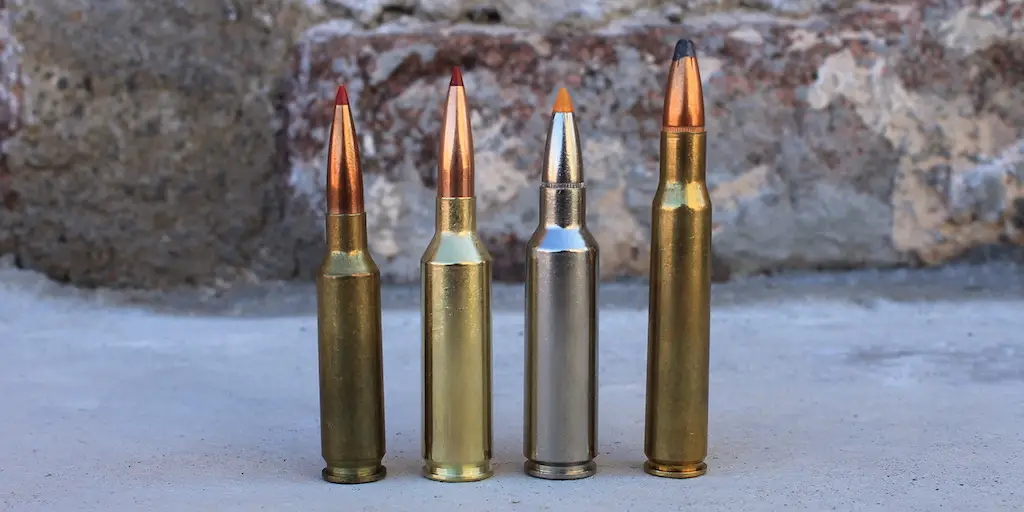
Pictured above: 6.5 Creedmoor, 6.5 PRC, 300 WSM, and .30-06 Springfield
What are the advantages of a short-action rifle over a rifle with a longer action length?
First, a short action rifle has a shorter bolt throw (and a correspondingly faster cycling time) than a standard or a magnum length action.
At the same time, those shorter length actions do also deliver a small advantage in accuracy due to their stiffer action.
Finally, proponents of short-action cartridges also argue that a shorter and wider powder column is more quickly ignited by the primer and burns more evenly than a comparable amount of powder in a longer and more narrow column. In theory, this results in improved accuracy for the shorter case.
All of those parameters eventually led him to decide on a 6.5 mm/.264-caliber round.
Garnder said to Outdoor Life:
I wanted the highest BC bullet you can push at 3,200 in a short action. The 6s can be pushed that fast, but they have lower BCs. The 7 mils have higher BCs but can’t be pushed at 3,200 fps in a short-action. The lack of bullet selection in the .25 and .270 ruled those out—so that’s why I settled on the 6.5.
After deciding on an appropriate caliber, he needed to select a case to serve as a parent to his new wildcat cartridge.
In addition to finding a case with just the right amount of power capacity (not too little, not too much) to reach his desired performance levels, Gardner also ideally wanted to use a case without a rebated rim and without a belt. This eliminated the .375 H&H and cartridges like the .264 Winchester Magnum and .300 Winchester Magnum descended from it.
The Winchester Short Magnum line of cartridges checked the beltless and non-rebated rim boxes, but had a little more case capacity than he was looking for.
Gardner initially wanted to use the Ruger Compact Magnum case (itself based on the .375 Ruger) as a parent case.
However, you might recall that we were in the middle of a massive ammo shortage in 2013.
For this reason, Hornady (which produced Ruger Compact Magnum brass), declined to work with him at first because they were stretched to capacity making brass for more popular cartridges like the .223 Remington and .308 Winchester that were the object of so much panic buying at the time.
For that reason, Gardner settled on the Remington Short Action Ultra Magnum (SAUM) as a parent case. Based on the Remington Ultra Magnum (itself descended from the .404 Jeffrey), the new 6.5 SAUM worked pretty well for his purposes, but Gardner was not 100% satisfied by the rebated rim case.
Fortunately, things did eventually calm down with the ammo panic buying and Hornady was able to turn their attention to what would become the 6.5 PRC and redesign the cartridge using a .300 Ruger Compact Magnum (RCM) case like Gardner originally wanted.
Hornady formally rolled out their new 6.5 Precision Rife Cartridge at the 2018 SHOT Show. The cartridge, along with .300 PRC (also descended from the .375 Ruger), received formal SAAMI approval later that year.
6.5 PRC Ballistics
Typical 6.5 PRC ballistics are a 143gr bullet at 2,960fps (2,782 ft-lbs) or a 147gr bullet at 2,910fps (2,764 ft-lbs). Both of these loads are designed to minimize bullet drop and wind drift at extended range. 6.5 PRC factory loads generally fire the same bullet approximately 200-250fps faster than the 6.5 Creedmoor.
With careful handloading, it’s possible to come very close to that 3,200fps goal Gardner had when he first designed the cartridge.
Specifically, maximum handloads published by Hornady show a velocity of 3,150fps with a 143 grain ELD-X bullet and a velocity of 3,050fps with a 147 grain ELD Match bullet. Both of those loads were obtained using a 26″ barrel, so your mileage may vary.
That is pretty impressive performance, especially from a cartridge that size!
6.5 PRC vs 6.5 Creedmoor
6.5 PRC factory loads usually fire the same bullet 200-250fps faster than the 6.5 Creedmoor. Therefore, 6.5 PRC has a flatter trajectory, more retained energy, and less wind drift than the 6.5 Creedmoor at typical hunting ranges. However, the 6.5 PRC has slightly more recoil than the 6.5 Creedmoor.
That’s how the 6.5 Precision Rifle Cartridge compares to the 6.5mm Creedmoor in a nutshell. As we drill down into the details of their similarities and differences though, several especially important factors emerge.
First, it may seem obvious, but I’ll say it anyway: the 6.5 Creedmoor and 6.5 PRC are completely different cartridges.
Do NOT attempt to interchange ammunition. Only shoot 6.5 Creedmoor ammo in 6.5 Creedmoor rifles and only shoot 6.5 PRC ammunition in 6.5 PRC rifles.
Continuing on, the 6.5 Creedmoor and the 6.5 PRC both fire the same .264″ diameter bullets. In fact, Hornady often uses the exact same bullets in factory loads for each cartridge.
Both cartridges were also purpose built for long range shooting. For this reason, they were designed to use the longest and heaviest bullets available for their caliber without intruding into the powder column. For these reasons, long, heavy for caliber bullets will fit in the magazine and chamber in 6.5mm Creedmoor and 6.5 PRC rifles.
Both cartridges are known for their exceptional accuracy and both are well suited for using high BC and high SD, heavy for caliber match grade hunting bullets.
Part of the reason they deliver such great accuracy is because both cartridges have a relatively “tight” throat diameter.
The throat is the smooth portion of a rifle barrel closest to the cartridge. Having a more snug throat diameter means there’s less room for the bullet to yaw upon firing before engaging the rifling. This can also help enhance accuracy.
Well, the 6.5 PRC and 6.5 Creedmoor both have throat diameters just .0005″ larger than the bullet diameter. This is a significant improvement over older cartridges like the 243 Winchester (.0033″), .264 Win Mag (.004″), 6.5×55 Swede (.0053″) or even the 308 Winchester (.002″).
The end result was both the 6.5 PRC and 300 PRC were optimized to accurately shoot very long, sleek, high BC bullets at magnum velocities and deliver outstanding accuracy in the process.
Most 6.5 Creedmoor and 6.5 PRC rifles usually have a relatively fast rifling twist rate (quite often 1:8″) in order to stabilize those long, heavy, high BC bullets. The 6.5 Creedmoor commonly uses 120gr, 140gr, 143gr, and 147gr bullets. While the 6.5 PRC can use those lighter bullets, it’s most commonly available with either 143gr or 147gr bullets.
Both cartridges use a minimally tapered case with a 30 degree shoulder.
However, the 6.5 Precision Rifle Cartridge is slightly longer, both in terms of case length and overall length, than the 6.5 Creedmoor. The 6.5 Creedmoor has a .473″ rim diameter, while the 6.5 PRC has a larger .532″ rim diameter.
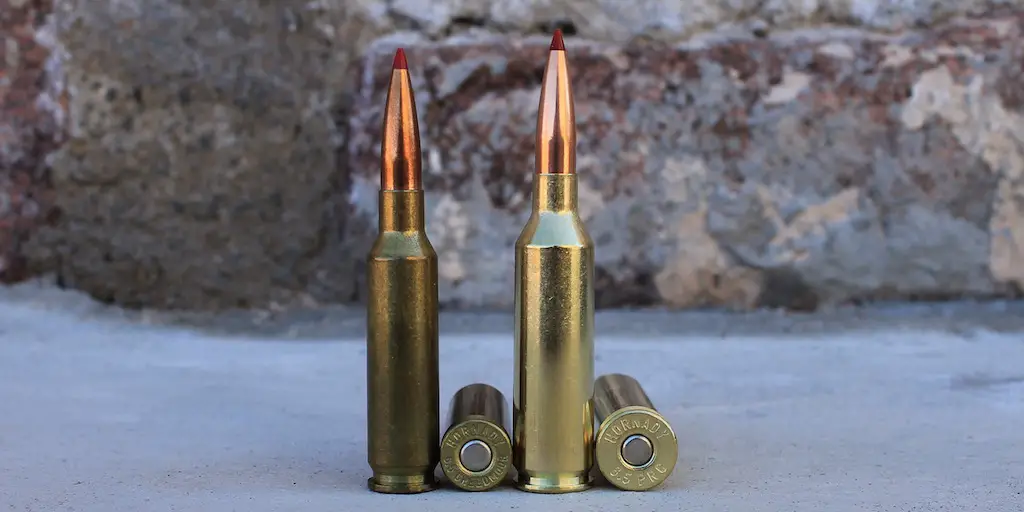
For these reasons, the 6.5 PRC actually has considerably more case capacity than the 6.5 Creedmoor (62gr vs 52.5gr of H2O). It also has a higher SAAMI maximum pressure of 65,000psi vs 62,000psi for the 6.5 Creedmoor.
Most manufacturers draw the line between short-action and long-action rifles somewhere around the overall length the Winchester Short Magnum cartridges (2.86″). Well, the 6.5 Creedmoor has an overall length of 2.825″, so it clearly fits the generally accepted parameters for short action cartridges.
However, with an overall length of 2.955″, the 6.5 PRC exceeds those standards by a hair.
So, while the 6.5 PRC is marketed as a short-action cartridge, that’s not strictly true. Even so, the cartridge still fits an impressive amount of performance into a compact package.
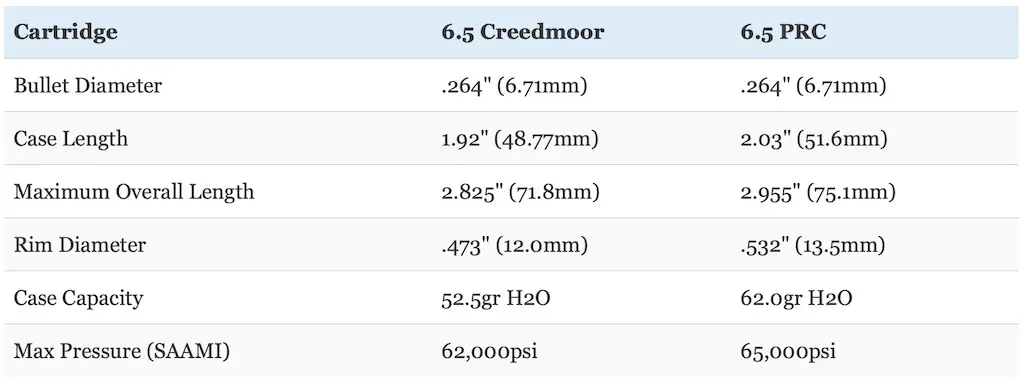
Note: while the powder capacity figures listed above do give a good indication of the differences between the two cartridges, exact case capacities vary slightly according to the brand of brass used.
The table below compares a 143gr Hornady ELD-X (.625 BC) load in 6.5 Creedmoor to a load shooting an identical bullet in 6.5 PRC. This data is for Hornady Precision Hunter factory ammo using a 200 yard zero and a 24 inch barrel.

As you can see, the 6.5 PRC has a flatter trajectory with about 8.2″ (18%) less bullet drop at 500 yards. The 6.5 PRC also has about 20% more energy at the muzzle and about 23% more energy remaining at 500 yards than the 6.5 Creedmoor.
Since this article is focused on the performance of these cartridges for hunting, I didn’t include any ballistic data past 500 yards in the table above. However, just to give you an idea of the superiority of the 6.5 PRC over the 6.5 Creedmoor at long range, consider this: the 6.5 Creedmoor has over 58″ (~23%) more bullet drop at 1,000 yards with a 200 yard zero.
To further illustrate that same point, consider the supersonic ranges of the two cartridges. This particular 6.5 Creedmoor load drops below the speed of sound around 1,475 yards, but the 6.5 PRC stays supersonic out until around 1,650 yards.
The chart below compares how much a 10 mile per hour crosswind impacts those same loads for each cartridge out to 500 yards.

At 500 yards, there’s just 1.8″ separating them.
At 1,000 yards, the 6.5 Creedmoor has about 9″ (~15%) more wind drift than the 6.5 PRC. That’s not nothing, but it’s not a gigantic difference either.
That’s not really surprising though. After all, the two cartridges are using the exact same bullet. So, the difference here is entirely due to the 260fps advantage in muzzle velocity the 6.5 PRC has.
Now let’s talk about recoil.
The table below compares a couple of handloads that approximate the performance of the factory loads given above when fired from identical Ruger Hawkeye Long Range rifles.
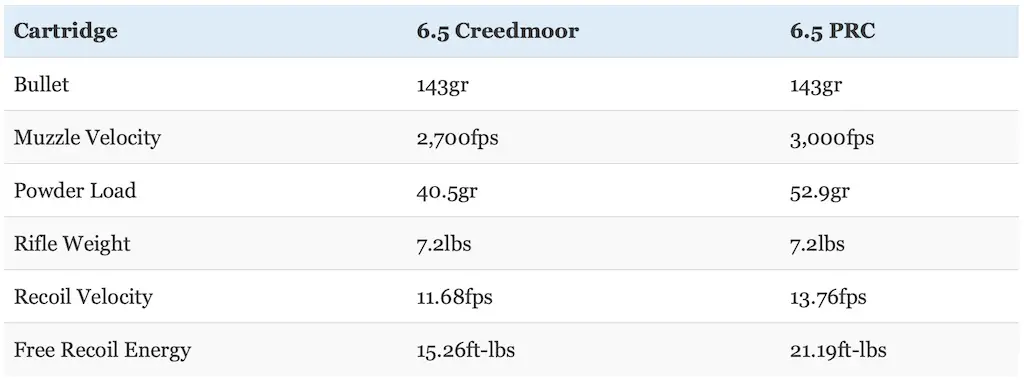
Felt recoil will vary from shooter to shooter and rifle to rifle, but free recoil energy is still a useful way to compare cartridges.
The 6.5mm Creedmoor is known for having a relatively mild recoil. However, the 6.5 PRC achieves that velocity advantage over the 6.5 Creedmoor at the expense of about 38% more free recoil energy.
As a point of comparison, the free recoil energy generated by the 6.5 PRC load above is slightly less than the recoil energy produced by a run of the mill .270 Winchester hunting load in a rifle that weighs the same. Yes, that’s quite a bit more than the 6.5 Creedmoor, but the 6.5 PRC is hardly a fire breathing, heavy recoiling magnum cartridge either.
Take all that for what you will.
So where do we stand overall with the 6.5 PRC vs 6.5mm Creedmoor?
Basically, the 6.5 PRC is capable of firing the same bullet somewhat faster than the 6.5 Creedmoor. That translates into a flatter trajectory, more resistance to wind drift, and more kinetic energy at typical hunting ranges.
If you want to use the 6.5 PRC for elk hunting, the additional couple hundred ft-lbs of kinetic energy the cartridge provides will certainly come in handy. The flatter trajectory and more resistance to wind drift of the 6.5 Precision Rifle Cartridge can also help with shot placement.
This does make the cartridge a little bit more forgiving of range or wind estimation errors than the 6.5 Creedmoor.
While this is probably not an issue for most hunters, typical 6.5 PRC barrel life is very likely shorter than typical 6.5 Creedmoor barrel life.
Since the two cartridges use the same diameter barrel, throat erosion occurs faster with the 6.5 PRC because it has substantially more case capacity. Simply put, burning more powder in an equally sized space will result in shorter barrel life.
This means that, in general, the 6.5 PRC will simply wear out barrels faster than the 6.5 Creedmoor will. Exactly how fast that occurs depends on a number of factors like the quality of the barrel, the exact ammunition used, etc.
For serious target shooters, this is a concern. However, the good news for hunters is that typical 6.5 PRC barrel life of 1,000-2,000 rounds is more than enough to last for many years of hunting with no issues at all.
So, while there is a difference in 6.5 Creedmoor vs 6.5 PRC barrel life, it probably isn’t going to be a big issue for most hunters.
Unfortunately, the 6.5 PRC does have quite a bit more recoil than the 6.5 Creedmoor though.
While many hunters should be able to handle the recoil of both cartridges without too much trouble, don’t underestimate the impact that recoil has on the ability of a person to shoot accurately either. Regardless of how well a given person handles recoil, all other things being equal, they will absolutely shoot better with a milder recoil.
A mild recoil also facilitates with spotting misses and taking a rapid follow up shot both at the range and afield.
Here’s one last thing to consider when comparing these cartridges: magazine capacity.
Since it uses a larger case diameter, most rifle magazines will hold more 6.5 Creedmoor cartridges than 6.5 PRC cartridges. Typically, a rifle magazine that can hold 4 (or sometimes 5) 6.5 Creedmoor cartridges will only be able to hold 3 6.5 PRC cartridges.
All things considered though, both cartridges are very accurate, flat shooting, and hit hard enough for use on a wide variety of game at practical hunting ranges. Regardless of whether you’re using a 6.5mm Creedmoor or a 6.5 PRC, no pronghorn, mule deer, or elk will go far if you put a well constructed bullet into the vitals.
Of the two cartridges though, the 6.5 Creedmoor is still by far the most popular with hunters. This is reflected in the prices, availability, and variety of factory ammunition and hunting rifles currently in production for each cartridge.
So, even though the 6.5 PRC does have some advantages on paper, don’t count out the 6.5 Creedmoor yet. It’s still a great hunting round and it’s a whole lot easier to find 6.5 Creedmoor rifles and loaded ammunition.
If you already have a 6.5 Creedmoor, there’s really not a big reason to upgrade to the 6.5 PRC unless you just want to.
For most hunters, the 6.5 Creedmoor is probably the better all around choice.
That said, the 6.5 PRC gives hunters the ability to wring a little bit more performance out of a 6.5mm cartridge without dealing with the more expensive ammunition, more recoil, and shorter barrel lives of more powerful 6.5mm cartridges like the 6.5 Remington Magnum, .264 Winchester Magnum, 26 Nosler, or 6.5-300 Weatherby.
For this reason, I can certainly understand why somebody would want to hunt with a 6.5 PRC, especially if that person didn’t already have a 6.5 Creedmoor (or another 6.5mm cartridge like the .260 Remington).
6.5 PRC Ammo
While the 6.5 Precision Rifle Cartridge does have a relatively large and dedicated following considering the fact that it’s still relatively new, the cartridge is not extremely popular in absolute terms and can’t hold a candle to cartridges like the .270 Winchester or .30-06.
I do expect this to change in the near future, but Hornady is the only major ammunition company currently producing 6.5 PRC ammo. The cartridge is available in both the Hornady Precision Hunter and Hornady Match lines with 143 grain ELD-X and 147 grain ELD Match bullets respectively.
Some people do hunt with the Match loads, but the Precision Hunter line is purpose built for long range hunting and is generally the better choice for most game.
Just as you’d probably expect, 6.5 PRC ammo is generally more expensive and not as easy to find as more popular cartridges. Since the cartridge is used by a relatively small segment of the hunting world, not every sporting goods store keeps 6.5 PRC ammo in stock.
Most of the big retailers in the USA will usually have a couple of boxes of each on hand, but it would be extremely unusual to find 6.5 Precision Rifle Cartridge ammunition in smaller gun store.
Availability of ammunition is usually pretty good online though and the bigger retailers typically have a good selection of quality factory 6.5 PRC ammo in stock.
BUY 6.5 PRECISION RIFLE CARTRIDGE HUNTING AMMO HERE
Fortunately, reloading components for the cartridge are widely available. The high price of factory ammo and the difficulty involved with obtaining a reliable supply of ammo at times makes it a good choice for handloaders.
Indeed, both cartridges offer a fair bit of options for handloaders.
Since it uses the same .264″ bullet size that’s also used by the 6.5 Grendel, 6.5 Swede, .260 Remington, and 6.5 Creedmoor (among others), reloaders have access to a BUNCH of outstanding quality bullets suitable for use on a wide variety of game to choose from.
6.5 PRC Rifles
Interestingly enough, the rise in popularity of long range precision shooting has resulted in a pretty good selection of high quality rifles available for the 6.5 Precision Rifle Cartridge.
Among other companies, Bergara, Browning, Christensen Arms, Fierce, GA Precision, Gunwerks, Howa, the Montana Rifle Company, Mossberg, Ruger, Sauer, Savage, and Seekins Precision all manufacture bolt action 6.5 PRC rifles.
So, while the selection of ammunition available for the cartridge is relatively small, hunters do have some very good quality rifles to choose from. In particular, and as was the case with the 6.5 Creedmoor initially, Ruger really got behind the 6.5 PRC from the start, so there are some particularly intriguing 6.5 PRC rifle options from the company these days.
BUY A RUGER 6.5 PRC HUNTING RIFLE HERE
BUY A CHRISTENSEN ARMS 6.5 PRC HUNTING RIFLE HERE
BUY A BROWNING 6.5 PRC HUNTING RIFLE HERE
Best 6.5 Precision Rifle Cartridge Ammo For Hunting
Unlike its little brother the 6.5 Creedmoor, there aren’t many options for factory 6.5 PRC hunting ammo right now. That’s slowly changing though.
If you’d like to learn more about some of the various hunting ammunition choices for the 6.5 PRC read this article:
Best 6.5 PRC Ammo For Hunting Deer, Elk, & Bear
In case you were wondering, Hornady Marketing Director Neil Davies used Hornady Precision Hunter ammunition on his chamois hunt in the video below.
Final Thoughts On The 6.5 PRC
The 6.5 PRC is a very well designed cartridge that offers some real advantages to hunters and fills a specific niche among the various 6.5mm cartridges. While a somewhat surprisingly large number of shooters and hunters have been quick to adopt the new cartridge, the small benefits it offers over more established calibers like the 6.5 Creedmoor probably aren’t significant enough to justify making the switch for most hunters.
This is especially true considering the lack of 6.5 Precision Rifle Cartridge ammo choices at this point. Even so, the selection of ammunition for the cartridge will likely improve in the future if the cartridge continues to grow in popularity. So, if you’re the type of person who wants to wring out all the performance you can from a certain caliber, by all means get a 6.5 PRC.
It’s a fantastic cartridge and I’m sure it will serve you well afield.
Do you have a rifle chambered in 6.5 PRC that you’re itching to take on a hunt?
Book an incredible black bear hunt here.
Book an outstanding Africa hunting safari here.
NEXT: 22-250 vs 223 vs 204 RUGER vs 220 SWIFT: CLASH OF THE SPEED DEMONS
NEXT: BEST GIFTS FOR HUNTERS
Enjoy this article about the 6.5 Precision Rifle Cartridge? Please share it with your friends on Facebook and Twitter.
John Snow and Dave Emary’s article for Outdoor Life and Phil Massaro’s article for Rifle Shooter Magazine were used as references for the history of the 6.5 PRC. The Hornady 10th Edition (p317-322) reloading manual (and their online supplement) provided data to compare their size and recoil of the 6.5 Creedmoor and 6.5 PRC. Chuck Hawks (here) provided the case capacity for the 6.5 Creedmoor and Rifle Shooter Magazine provided case capacity for the 6.5 PRC. The data used to compare the trajectory of the cartridges was obtained from Hornady (here, and here). Maximum pressure for the 6.5 Creedmoor and maximum pressure and cartridge dimensions for the 6.5 PRC were obtained from SAAMI (p26 for the 6.5 Creed) and here for the 6.5 PRC. I used Shooters Calculator to compare trajectories, wind drift, and recoil for the cartridges.
Make sure you follow The Big Game Hunting Blog on Facebook, Instagram, Twitter, and YouTube.
John McAdams is a proficient blogger, experienced shooter, and long time hunter who has pursued big game in 8 different countries on 3 separate continents. John graduated from the United States Military Academy at West Point and is a veteran of combat tours with the US Army in Iraq & Afghanistan. In addition to founding and writing for The Big Game Hunting Blog, John has written for outdoor publications like Bear Hunting Magazine, The Texas State Rifle Association newsletter, Texas Wildlife Magazine, & Wide Open Spaces. Learn more about John here, read some of John’s most popular articles, and be sure to subscribe to his show: the Big Game Hunting Podcast.

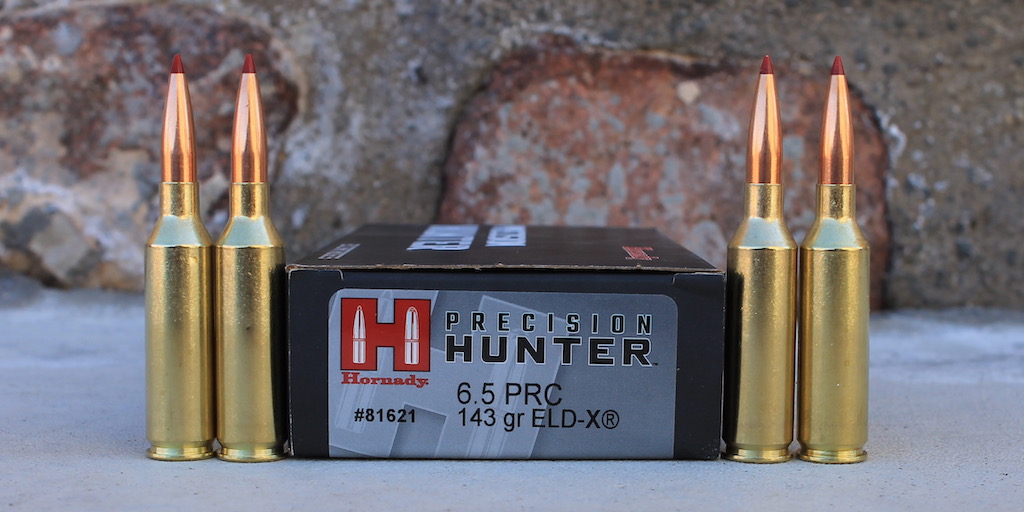

I have both 6.5 creedmoor and 6.5 prc. I use 129ABLR at 2912 fps w/w760 powder, 44gr, 1/2″ group in my creedmoor. In the 6.5prc I use 142 ABLR at 2903 fps w/H1000 at 57gr, 3/4″ group.
I like both guns and use both at 1000 yd. range.
Great article. Thank you.
John McAdams this is an excellent critical analysis of the comparison between the 6.5 Creedmoor and the 6.5 PRC. I recommend this article to anyone who wants to know the difference pro and con of the two calibers. Thank you for this help on making a decision on these calibers. Hats off to you sir for a job well done! John